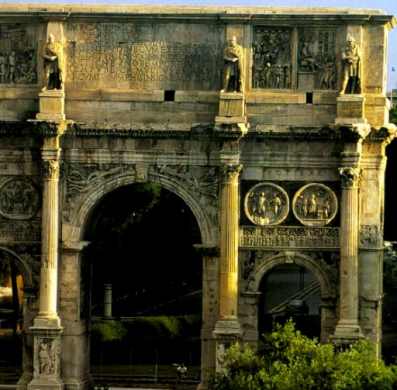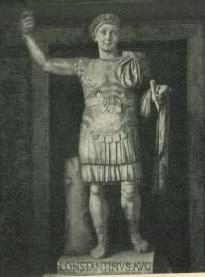| Konstantin I., der Große |
Konstantin I., der Große (Römisches Reich), eigentlich Flavius Valerius Constantinus, (um 274 bis 337), römischer Kaiser (306-337); der erste römische Kaiser, der sich zum Christentum bekannte. Konstantin war der Begründer Konstantinopels (des heutigen Istanbul), der Hauptstadt des Oströmischen Reiches (später des Byzantinischen Reiches) bis 1453.
2. DIE FRÜHEN JAHRE
Konstantin wurde in Naissus (Nis) als Sohn von Constantius I. und dessen Konkubine Helena (später heilige Helena) geboren. Nach der Ernennung Constantius' zum Augustus (305) begleitete Konstantin seinen Vater 306 nach Britannien. Als Constantius noch im gleichen Jahr starb, wurde Konstantin von den Truppen, bei denen er sehr beliebt war, zum Kaiser ausgerufen. In den folgenden zwei Jahrzehnten musste Konstantin jedoch seine Herrschaft gegen die Angriffe mehrerer Rivalen verteidigen, und erst 324 konnte er sich als Alleinherrscher durchsetzen.
Der Tradition seines Vaters und der Kaiser des 3. Jahrhunderts folgend, war Konstantin noch dem Glauben an römische Gottheiten verhaftet, vor allem dem Glauben an den Sonnengott Sol, die sichtbare Manifestation des unsichtbaren höchsten Gottes (summus deus). Dieser Gott wurde als das Prinzip hinter dem Universum angesehen und galt als Begleiter des römischen Kaisers. Am Vorabend der Entscheidungsschlacht gegen Maxentius, seinen Rivalen in Italien, im Jahr 312, soll Konstantin der Legende nach ein Kreuz mit der Inschrift "In diesem Zeichen wirst Du siegen" (traditionell lateinisch wiedergegeben mit "in hoc signo vinces") erschienen sein. Konstantin brachte Maxentius an der Milvischen Brücke in der Nähe von Rom die entscheidende Niederlage bei. Der Senat empfing den Sieger als Retter des römischen Volkes. Konstantin, der bislang den Sonnengott verehrt hatte, sah jetzt in der christlichen Gottheit die siegbringende und beendete die Christenverfolgung. Zusammen mit Licinius, seinem Mitregenten, erließ er 313 das Edikt von Mailand, das den Christen im Römischen Reich die freie Religionsausübung gestattete und die alte römische Staatsreligion abschaffte. Das Christentum wurde der römischen Religion gleichgestellt und eingezogener Besitz den Christen zurückerstattet. Das Christentum entwickelte sich jetzt zu einer Massenreligion.
3. ALLEINHERRSCHAFT
Zwischen Licinius und Konstantin entwickelte sich in der Folgezeit ein Machtkampf, aus dem Konstantin 324 als Alleinherrscher hervorging. Als Kaiser über Ost und West führte Konstantin das Reformprogramm seines Vorgängers Diokletian fort und baute das Verwaltungssystem weiter aus, reorganisierte das Heer und vollendete die Trennung von militärischer und ziviler Gewalt. Konstantin führte auch eine neue Goldmünze (den solidus) ein, die die Währung sanierte und die bis zum Ende des Byzantinischen Reiches die Standardwährung blieb. Aus politischen und religiösen Motiven bemühte sich Konstantin um die kirchliche Einheit. 325 berief er das erste ökumenische Konzil nach Nicäa ein, dessen Ausgang er wesentlich mitbestimmte. Konstantin verlegte den Schwerpunkt seiner Herrschaft nach Osten und ließ von 326 bis 330 die alte griechische Stadt Byzanz unter dem Namen Konstantinopel zur neuen Hauptstadt des Reiches ausbauen, im bewussten Gegensatz zum heidnischen Rom. Außerdem errichtete er Kirchen im Heiligen Land, wo seine Mutter (auch eine Christin) der Legende nach das Kreuz Christi gefunden haben soll. Kurz vor seinem Tod am 22. Mai 337 empfing Konstantin die Taufe.
4. BEURTEILUNG
Konstantin einte ein wankendes Weltreich, reorganisierte das Staatswesen und bereitete den Boden für den Sieg des Christentums gegen Ende des 4. Jahrhunderts. Viele moderne Historiker erkennen die Aufrichtigkeit seiner religiösen Haltung an. Seine Hinwendung zum Christentum war ein stufenweiser Prozess: Zunächst mag Konstantin Christus mit dem siegbringenden Sonnengott assoziiert haben, beim Konzil von Nicäa im Jahre 325 war er jedoch bereits durch und durch Christ, duldete aber auch weiterhin die alten römischen Religionen in seinem Reich. Konstantin war der erste Kaiser, der im Namen Christi regierte. Er begründete den Anspruch, dass der Kaiser als Stellvertreter Christi nicht nur Herr des Staates, sondern auch Herr der Kirche sei, und legte damit den Grundstein für das mittelalterliche christliche Europa.
 Constantine
the Great (c. AD 274-337), Roman emperor (306-337), the first Roman
ruler to be converted to Christianity. He was the founder of Constantinople
(present-day Istanbul), which remained the capital of the Eastern Roman
(Byzantine) Empire until 1453.
Constantine
the Great (c. AD 274-337), Roman emperor (306-337), the first Roman
ruler to be converted to Christianity. He was the founder of Constantinople
(present-day Istanbul), which remained the capital of the Eastern Roman
(Byzantine) Empire until 1453.
Early Life
Constantine
was born Flavius Valerius Constantinus at Nis, in what is now Serbia,
son of the commander Constantius Chlorus (later Constantius I) and Helena
(later St Helena), a camp follower. Constantius became Co-Emperor in 305.
Constantine, who had shown military talent in the East, joined his father
in Britain in 306. He was popular with the troops, who proclaimed him
Emperor when Constantius died later the same year. Over the next two decades,
however, Constantine had to fight his rivals for the throne, and he did
not finally establish himself as sole ruler until 324. Following the example
of his father and earlier 3rd-century emperors, Constantine in his early
life was a solar henotheist, believing that the Sun god, Sol, was the
visible manifestation of an invisible "Highest God" (summus deus), who
was the principle behind the universe. This god was thought to be the
companion of the Roman emperor. Constantine's adherence to this faith
is evident from his claim of having had a vision of the Sun god in 310
while in a grove of Apollo in Gaul. In 312, on the eve of a battle against
Maxentius, his rival in Italy, Constantine is reported to have dreamt
that Christ appeared to him and told him to inscribe the first two letters
of his name ("XP" in Greek) on the shields of his troops. The next day
he is said to have seen a cross superimposed on the Sun and the words
"in this sign you will be the victor" (usually given in Latin, in hoc
signo vinces). Constantine then defeated Maxentius at the Battle of the
Milvian Bridge, near Rome. The Senate hailed the victor as saviour of
the Roman people. Thus, Constantine, who had been a pagan solar worshipper,
now looked upon the Christian deity as a bringer of victory. Persecution
of the Christians was ended, and Constantine's co-emperor, Licinius, joined
him in issuing the Edict of Milan (313), which mandated toleration of
Christians in the Roman Empire. As guardian of Constantine's favoured
religion, the Church was then given legal rights and large financial donations.
Sole Ruler
A struggle
for power soon began between Licinius and Constantine, from which Constantine
emerged in 324 as a victorious Christian champion. Now emperor of both
East and West, he began to implement important administrative reforms.
The army was reorganized, both to meet the increasing barbarian threat
from outside the empire and to reduce the possibility of military commanders
seizing power for themselves. The widespread economic and administrative
reforms and the separation of civil and military authority initiated by
his predecessor, Diocletian, were confirmed and extended. An increasingly
centralized government regulated every aspect of life throughout the empire
through a large professional bureaucracy. The central government was run
by Constantine and his council, known as the sacrum consistorium. The
Senate was given back the status that it had lost in the 3rd century,
and the progressive disintegration of the money economy was checked by
the issue of new gold coins (solidi), which remained the standard of exchange
until the end of the Byzantine Empire. Constantine intervened in ecclesiastical
affairs to achieve unity; he presided over the first ecumenical council
of the Church at Nicaea in 325. He also began the building of Constantinople
in 326 on the site of ancient Greek Byzantium. The city was completed
in 330 (later expanded), given Roman institutions, and beautified by ancient
Greek works of art. In addition, Constantine built churches in the Holy
Land, where his mother (also a Christian) supposedly found the True Cross
on which Jesus was crucified. The emperor was baptized shortly before
his death, on May 22, 337.
Evaluation
Constantine unified a tottering empire, reorganized the Roman state, and
set the stage for the final victory of Christianity at the end of the
4th century. Many modern scholars accept the sincerity of his religious
conviction. His conversion was a gradual process; at first he probably
associated Christ with the victorious Sun god. By the time of the Council
of Nicaea (325), however, he was completely Christian, but still tolerated
paganism among his subjects. Although criticized by his enemies as a proponent
of a crude and false religion, Constantine strengthened the Roman Empire
and ensured its survival in the East. As the first emperor to rule in
the name of Christ, he was a major figure in the foundation of medieval
Christian Europe.
Costantino I il Grande Flavio Valerio Costantino (Naisso, l'odierna Ni, in Serbia 274 ca. - presso Nicomedia 337), imperatore romano (306-337), il primo a convertirsi al cristianesimo. Fondò Constantinopoli (l'odierna Istanbul), che rimase la capitale dell'impero bizantino fino al 1453.
Figlio di Costanzo Cloro e di Elena (in seguito proclamata santa), Costantino trascorse la giovinezza alla corte di Diocleziano; nel 305, in virtù del nuovo sistema politico della tetrarchia, il padre divenne imperatore e Costantino, che aveva dimostrato il proprio talento militare in Oriente, lo raggiunse in Britannia. Grazie alla sua popolarità fra i legionari, alla morte del padre (306) venne proclamato imperatore. Tuttavia, nel ventennio seguente fu costretto a combattere contro gli altri pretendenti al trono (Massimiano, Massenzio, Licinio, Galerio e Massimino Daia), e riuscì a imporsi come unico imperatore solo nel 324.
Morti Galerio e Massimiano, nel 312 Costantino, alleatosi con Licinio, si mosse contro Massenzio: secondo la leggenda, alla vigilia della battaglia all'imperatore apparve in sogno Gesù, che gli chiese di scrivere le prime due lettere del proprio nome (in greco XP) sugli scudi dei suoi soldati. Il giorno seguente Costantino avrebbe visto una croce stagliarsi contro il sole, e nel cielo sarebbero apparse le parole: "In hoc signo vinces" ("In questo segno vincerai"). L'episodio segnò l'inizio della sua conversione al cristianesimo. Il giorno dopo sconfisse Massenzio nella battaglia di Ponte Milvio, nei pressi di Roma, e il senato riconobbe la legittimità del vincitore e gli attribuì il titolo di augusto. Costantino salì al trono d'Occidente insieme a Licinio (proclamato augusto nel 308 e imperatore d'Oriente) e nel 313 firmò l'editto di Milano, che pose fine alle persecuzioni contro i cristiani nell'impero romano.
Sconfitto Massimino Daia dal rivale Licinio, ben presto l'antagonismo tra i due augusti, Costantino e Licinio, scatenò una vera e propria lotta per il potere: le due battaglie di Adrianopoli e Crisopoli determinarono la vittoria del primo, che dal 324 divenne unico imperatore d'Oriente e d'Occidente. Con la sua energica azione politica si prefisse di unificare un impero vacillante, anche se di fatto la profonda spaccatura fra le tradizioni culturali e spirituali della parte bizantina e di quella romana dell'impero era ormai insanabile.
Costantino attuò importanti riforme amministrative: riorganizzò l'esercito, di cui si proclamò comandante supremo, e completò la separazione fra autorità civile e militare, iniziata dal suo predecessore Diocleziano. L'impero venne suddiviso in quattro prefetture e fu costituito un nuovo consiglio della corona, noto come il sacrum consistorium, composto da membri permanenti; il senato di Roma e quello di Bisanzio vennero invece trasformati in semplici consigli cittadini. Costantino fece coniare nuove monete d'oro (solidi), che rimasero la base di scambio fino alla fine dell'impero bizantino.
L'imperatore intervenne anche nelle questioni di dottrina religiosa e presiedette il primo concilio ecumenico della Chiesa a Nicea (325). Nel 326 diede inizio alla costruzione di Costantinopoli, sul sito dell'antica città greca di Bisanzio, dove trasferì la capitale dell'impero, ed eresse chiese in Terra Santa. Nel 332 il figlio Costanzo sconfisse i goti; pochi anni dopo, il re di Persia Sapore II pretese alcune province dell'impero. Costantino si pose alla testa di un esercito e mosse contro Sapore, ma morì nei pressi di Nicomedia, in Bitinia; fu battezzato poco prima di spegnersi, il 22 maggio dell'anno 337.
| Quelle: Microsoft Encarta |
